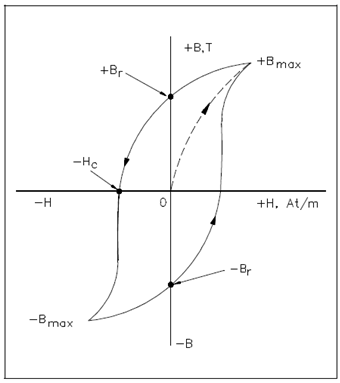Hysteresis:
Whenever current in a coil reverses direction thousands of times per second, hysteresis could cause considerable loss of energy. It is described as "a lagging behind." A magnetic flux in an iron core lags behind the magnetizing force.
The hysteresis loop is a series of curves which displays the features of a magnetic material shown in above figure. Opposite directions of current will result in opposite directions of flux intensity displays as +H and -H. Opposite polarities are also display for flux density as +B or -B. Current begin at the center (zero) when unmagnetized. The Positive H values increase B to the saturation point, or +Bmax, as displays through the dashed line. Then H decreases to zero, but B drops to the value of Br due to hysteresis. Through reversing the original current, H now becomes negative. B drops to zero and continues on to -Bmax. Like the -H values decrease (less negative), B is reduced to -Br when H is zero. Along With a positive swing of current, H once again becomes positive, generates saturation at +Bmax. The hysteresis loop is finished. The loop does not return to zero since of hysteresis.

Figure: Hysteresis Loop for Magnetic Materials
The value of +Br or -Br, that is the flux density remaining after the magnetizing force is zero, is known as the retentivity of which magnetic material. A value of -Hc that is the force which must be applied in the reverse direction to reduce flux density to zero, is known as the coercive force of the material.
The greater the area within the hysteresis loop, A larger the hysteresis losses.